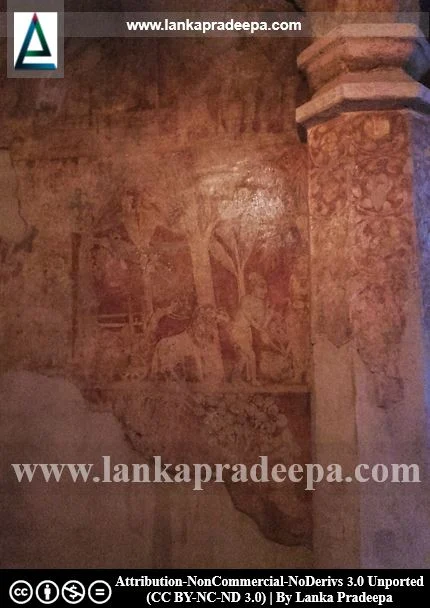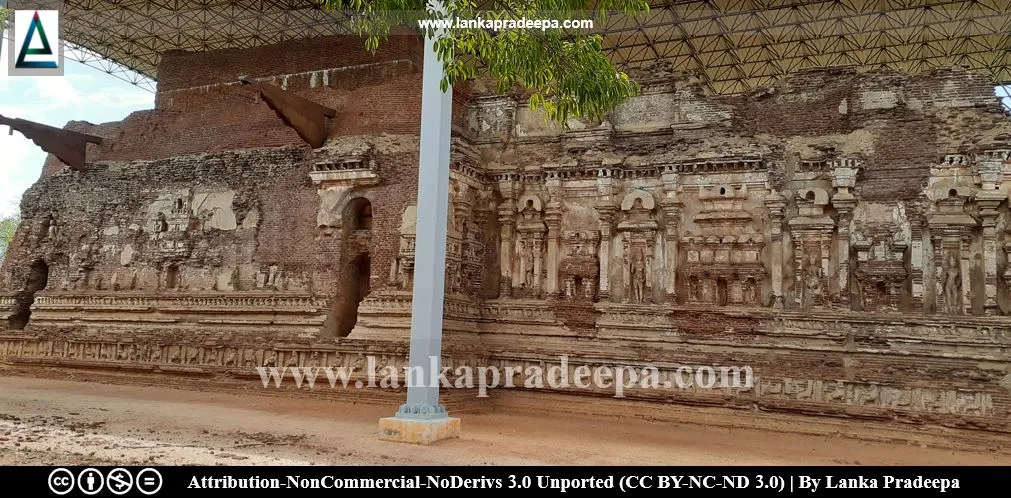
Thivanka Pilimage/ Pilima Geya, or Tivanka image house (Sinhala: තිවංක පිළිම ගෙය) is a Gedige (vaulted) type image house located in the Ancient City of Polonnaruwa, Sri Lanka. This image house is famous across the country for its 12th-century paintings belonging to the Polonnaruwa Period.
History
Constructed by King Parakramabahu I (1153-1186 A.D.), Thivanka Pilimage was the image house that belonged to the ancient Jetavanarama monastery (Nicholas, 1963; Wikramagamage, 2004).
Rediscovery
The image house which was covered by jungle for about five centuries was rediscovered in 1885, by S. M. Burrows (Wikramagamage, 2004).
Image house
The walls and the roof of Thiwanka Pilimage have been completely built out of bricks and therefore, known as a Gedige-type image house (Wikramagamage, 2004). There are three examples of this type of vaulted-roof shrine at Polonnaruwa; viz: Thivanka Pilimage, Lankathilaka Pilimage, and Thuparama Pilimage. The original brick vaulted roof of the image house, however, no longer exists but a fragment of it is still visible at the south of the shrine.
The image house is about 133 ft. long and the ground plan mainly consists of four parts, viz: the Garbhagrha (the sanctum), the Antarala (the vestibule), and the Mandapa, and the entrance porch (Prematilleke, 1990). The main entrance of the shrine is facing the east and a flight of steps associated with two Korawak Gal (wingstones) and two Muragal (guard stones) can be seen at the beginning of the entrance. A subsidiary entrance/exit is found on the north wall of the Mandapa (Prematilleke, 1990).
A giant headless standing Buddha statue with broken hands is found in the Garbhagrha. The statue is standing on a lotus base in a relaxed posture and is considered a unique piece of work belonging to the Polonnaruwa Period. The statue is bent at three places, namely the shoulder, the waist, and the knee and therefore called a Thivanka/Tribhanga (meaning three bends) statue. The image house is today called Thivanka Pilimage due to this large bent Buddha statue.
The Buddha statue has been built attached to a screen wall. Between the screen wall and the inner side of the rear wall of the image house is a narrow ambulatory (Ray 1960). The ambulatory is 4 ft. 6 in. in breadth and the two walls (the screen wall and the rear wall) are joined together at a height of 19 ft. 8 in. (Ray 1960). Besides the ambulatory at the ground floor level, it is said that there was another ambulatory around the statue on the upper level.
The exterior walls of the image house have been adorned with decorative sculptures depicting miniature edifices (Vimana) together with Bodhisattvas, deities, lions, swans, and dwarf figures in various postures.
Paintings
The Thivanka image house is most noteworthy for its paintings of the Polonnaruwa Period. It is the only image house in the ancient Polonnaruwa city that retains most of the original paintings that decorated the monument (Prematilleke, 1990).
The inner walls of the image house are adorned with paintings depicting certain incidents from the life of the Buddha and Jataka stories (stories of past births of the Buddha). The walls of the entrance porch and Mandapa are filled with murals showing Jataka stories such as Sasa, Vessanthara, Guttila, Sama, etc. (Wikramagamage, 2004). Several incidents from the Buddha's life such as Devaradhana (the Gods'request), and the Buddha's descent from heaven to the City of Sankassa, etc. are found drawn on the inner walls of the Garbhagrha (Prematilleke, 1990).
 Buddha in a rowing boat
Buddha in a rowing boat
(From Thivanka Pilimage, 12th century A.D.)
This is a replica of the original painting extracted from the Thivanka Pilimage and is presently on the display at the Painting Gallery of the National Museum of Colombo. It has been copied by D. A. L. Perera for the Department of National Museum but the copying date is unknown (Rambukwella, 2014). The location of this painting can not be identified as it completely faded away from the image house.
This painting depicts a life incident of the Buddha but the exact scene has not been identified. The Buddha in the painting is sitting on a boat with several other human figures. The left hand of the Buddha is resting on his left knee while the right hand is placed on the lap. Two figures (apparently a royal couple) are standing on the boat to the left of the Buddha and another figure is standing on the other side. Two boatmen at either end are rowing the boat.
 Buddha in a rowing boat
Buddha in a rowing boat (From Thivanka Pilimage, 12th century A.D.)
This is a replica of the original painting extracted from the Thivanka Pilimage and is presently on the display at the Painting Gallery of the National Museum of Colombo. It has been copied by D. A. L. Perera for the Department of National Museum but the copying date is unknown (Rambukwella, 2014). The location of this painting can not be identified as it completely faded away from the image house.
This painting depicts a life incident of the Buddha but the exact scene has not been identified. The Buddha in the painting is sitting on a boat with several other human figures. The left hand of the Buddha is resting on his left knee while the right hand is placed on the lap. Two figures (apparently a royal couple) are standing on the boat to the left of the Buddha and another figure is standing on the other side. Two boatmen at either end are rowing the boat.
Asankhavathi Jataka with a scene of a couple in a conjugal union
(Inner south wall of the entrance porch, below the Vessantara Jataka scene, Thivanka Pilimage)
Bodhisattva Brahmin picked up an infant left on a lotus flower and brought her up as a beautiful lady. The king was attracted to her and won her to be his queen after a trying test of determining her name, Asankhavati. The scene portrays a jungle environment where a couple enjoys themselves in conjugal union, the Brahmin picking up the child, and the girl being brought up in a hut.
 .
.
Stucco decorative sculptures
Several head fragments of stucco sculptures recovered from Lankatilaka and Tivanka image houses in Polonnaruwa have been presently preserved in the National Museum of Colombo. These clay-made figures that formed decorative friezes of the plinths of the aforesaid two image houses have a humorous and dwarfish countenance. The hairstyles, broad lips, teeth, and large open eyes have also intensified the amusing appearance of these figures.
These decorative sculptures belong to the 12th century A.D. and are examples of the primitive clay figurines of the ancient folk art tradition.
These decorative sculptures belong to the 12th century A.D. and are examples of the primitive clay figurines of the ancient folk art tradition.
A protected monument
The Thiwanka Pilima Geya located in the Athumalpitiya village in the
Divisional Secretary’s Division, Thamankaduwa is an archaeological
protected monument, declared by a government
gazette notification published on 4 June 2004.





.
References
1) Nicholas, C. W., 1963. Historical topography of ancient and medieval Ceylon. Journal of the Ceylon Branch of the Royal Asiatic
Society, New Series (Vol VI). Special Number: Colombo. Royal Asiatic
Society (Ceylon Branch). p.179.
2) Prematilleke, L., 1990. The architecture of the Polonnaruwa Period B.C.800-1200 A.D. Wijesekara, N. (Editor in chief). Archaeological Department centenary (1890-1990): Commemorative series: Volume III: Architecture. Department of Archaeology (Sri Lanka). pp.51-52.
3) Rambukwella, M.W.C.N.K., 2014. Heritage representation in culturally
diverse societies: a case study of the Colombo National Museum in Sri
Lanka (Doctoral dissertation, School of Museum Studies). p.363.
4) Ray, H. C. (Editor in Chief), 1960. University of Ceylon: History of Ceylon (Vol 1, part II). Ceylon University Press. pp.597-598.
4) Ray, H. C. (Editor in Chief), 1960. University of Ceylon: History of Ceylon (Vol 1, part II). Ceylon University Press. pp.597-598.
5) The Gazette of the Democratic Socialist Republic of Sri Lanka. No: 1344. 4 June 2004. p.15.
6) Wikramagamage, C., 2004. Heritage of Rajarata: Major natural, cultural and historic sites. Colombo. Central Bank of Sri Lanka. p.225-226.
6) Wikramagamage, C., 2004. Heritage of Rajarata: Major natural, cultural and historic sites. Colombo. Central Bank of Sri Lanka. p.225-226.
Location Map
This page was last updated on 20 November 2022




